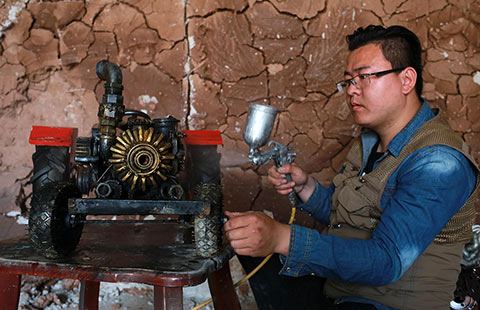Chinese exporters expect mild growth this year
(Agencies) Updated: 2012-10-22 11:21Chinese exporters at Asia's largest trade fair expect orders for made-in-China products to remain resilient for the rest of this year and even grow slightly despite shriveling demand from debt-stricken Europe and the strengthening yuan currency.
A Reuters poll of 85 small to medium-sized exporters at China's Canton Fair found that while around a quarter of firms surveyed expected orders to drop this year, overall, orders were seen rising an average 4 percent in 2012 and 7.4 percent in 2013.
The results are reflected in Chinese trade data in September which showed exports growing 9.9 percent year-on-year, almost twice the rate expected, while imports returned to expansion after a period in the doldrums. Chinese officials have warned however that it was just one month's data and not enough to predict a trend.
"Pent-up demand that was withheld in the third quarter is being released in the fourth quarter and that will provide support for China's exports," said Tim Condon, ING's head of Asian research.
While trade sentiment can be difficult to gauge across diverse and seasonally-influenced sectors, the Canton Fair, crammed this autumn with an estimated 24,000 exporters, is a closely watched biannual indicator of China's gargantuan export market.
In the halls of the fair, set beside the Pearl River in Guangzhou city, there was much talk of global economic weakness sapping demand for Chinese goods. But there was also an undercurrent of resilience as Chinese factory owners shift to cheaper inland regions, launch higher-value-added products and tap new markets abroad and at home.
Forty-six percent of those polled across a range of sectors including chemicals, machinery, electronics, household appliances, construction materials and computing hardware, were optimistic about their prospects, while 41 percent were neutral and 13 percent pessimistic.
Yuan weighs
The steady strengthening of the yuan has also been a burden on exporters who have borne a nearly 30 percent appreciation of the currency against the greenback since 2005, making Chinese products relatively more expensive.
Ken Bloom, CEO of INTTRA, a firm handling bookings for nearly 18 percent of global container traffic, said the US Federal Reserve's fresh bout of quantitative easing last month that depressed the US currency and pushed the yuan to a record high against the dollar earlier this month, was hurting Chinese exporters.
"As the dollar decreases its value, the exporting countries that are pegged to the dollar, the countries of Southeast Asia, have seen a pickup in their exports at the expense of China," he said.
Exporters at the Canton Fair indicated that should the yuan appreciate just another 4 percent to 5.99 to the US dollar, they would start to lose money. The yuan closed on Friday at 6.25 yuan to the greenback.
"China is losing its competitiveness," said Pradip Mithani, an Indian businessman at the fair who was looking for bicycles and other products for African markets. He said he was now buying a large number of lower-end products from India.
"In four to five years time, the impact of this (yuan appreciation) policy will be very high."
Despite the recent uptick in September China exports, trade officials have sought to dampen talk of a broad recovery. Canton Fair organizers said the number of foreign buyers in the fair's opening week had fallen 11.4 percent compared with the same period in the spring session.
"We are happy to see that the September trade data has shown some positive changes," Commerce Ministry spokesman Shen Danyang told a news conference on Friday. "But with only a single month's figure, it is still not enough to judge a trend of recovery due to the complicated external economic environment."
Domestically, economists say China likely hit the bottom of a seven-quarter long economic downturn between July and September, but recovery prospects remain tepid.
Participants at the fair expressed doubts about global conditions.
"The next year perhaps Italy and France could also have big problems so the demand for Chinese goods will fall further," said Javier Rodriguez Rivas, a buyer of light bulbs and plumbing materials who said he was ordering 20 percent less goods at this fair given weaker consumer demand back home in Spain.
Bankrupt
One out of every 10 exporters polled said they were worried about going bankrupt.
"I'm pessimistic about demand, even in Africa, the Middle East and also Southeast Asia," said Yu Yuefeng, the industrialist owner of the Phoenix bicycle brand in Shanghai, who exports around three million bicycles each year.
"Many of our customers say they still have a lot of stock as sales have been very slow ... This is worse than the financial crisis (in 2008 and 2009), because the pain and uncertainty has dragged on for longer."
To cope with leaner times, higher costs and scarcer orders, many exporters, about 62 percent, said they had developed and launched new, higher value-added products in the past 12 months.
"It's almost impossible to compete for standard products so we have to innovate. The greatest challenge for us is against other Chinese rivals," said Yi Jichun, whose firm Jiuzhou has moved into producing high-definition routers and mini projectors from manufacturing cables and wires.
While the survey found an average production cost rise of 8.7 percent this year, exporters had only raised prices an average of 1.6 percent. Twenty percent had also moved some production to cheaper inland regions over the past year.
Many exporters said, however, that production cost hikes this year have been offset by a substantial fall in raw material costs such as copper, aluminum and steel, though wage inflation remains an issue with 66 percent of respondents experiencing labor shortages in China.
- Vietnam spends $10.7b on Chinese imports in Q1: statistics
- Australian govt to closely scrutinize sale of cattle empire to Chinese firm
- BOC approved to set up local branch in Brunei
- China Unicom forecasts Q1 profit drop
- Finance minister: China and US rely on each other
- Spending reduced in three key areas
- Shanghai launches yuan gold fix
- Experts welcome Hesteel's Serbian steel buy

















